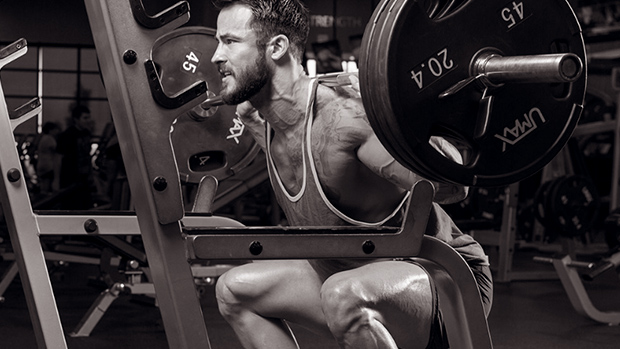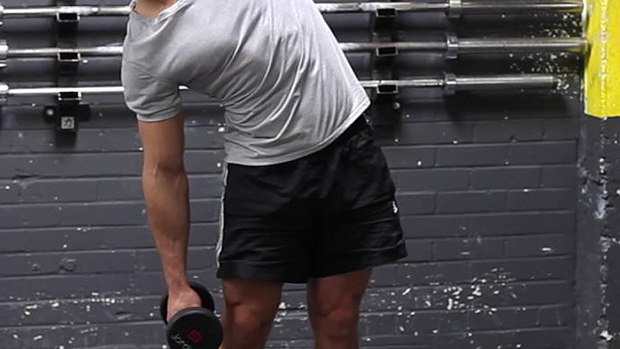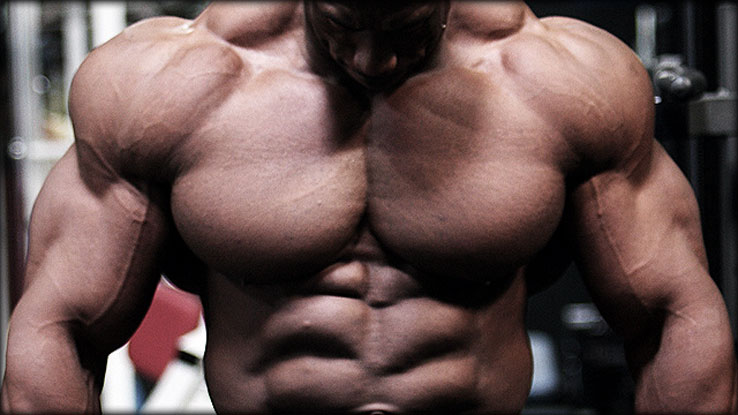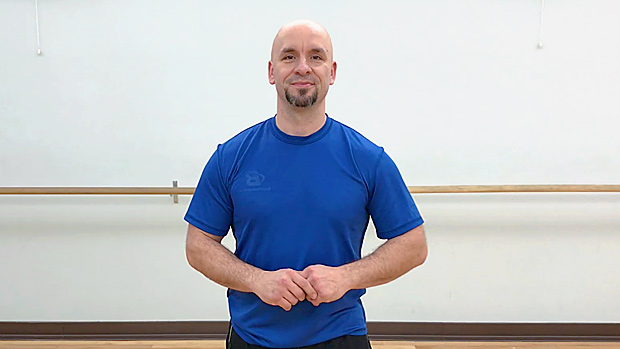There's a lot of misinformed squat advice on-line, and unfortunately, I've read most of it. Thanks to relying heavily on the Internet for explanations on how to lift, I spent two years squatting with horrible form (and it took me just as long to un-learn my bad form).
I don't want anyone else to have to go through that – and if you follow the advice in this article, you won't have to.
I have one goal with the squat and it's 600 pounds, raw. It torments me every day, and keeps me awake at night. I'll never be able to tell myself I'm strong until I do it.
In pursuit of 600 I've been injured repeatedly, needed people to help me stand for months, and laid in hospital beds with my crying mother sitting next to me.
I've felt guilty at times, but not once did quitting ever enter my mind. I'm not bragging, because it became an unhealthy obsession.
I've been ready to lie, cheat, and steal to get there; and cheat I did, which ultimately set me back. I've used every trick I could think of. I tried to widen my stance to decrease ROM and it ruined my otherwise okay form.
I tried ammonia, and would get wildly fired up for big sets hoping it would help. I used to smash my head against the bar until I bled. I went through four different shoes of varying heel heights, knee sleeves, Reh-band shorts, the list goes on and on.
Finally, I opened myself to good advice and received just that from a close friend and amazing lifter, Willie Albert. Willie is the 2010 WPC Raw World Champion with a 252.5 kg squat, a 170 kg bench, and a 325 kg deadlift, all done at 82.5 kg and with beautiful, textbook form.
Willie Albert "missing" a 727-pound deadlift, at a bodyweight of 181 pounds.
But Willie's advice was anything but easy. He had me squat every day for 6 weeks, doing 10 singles with 405 one week, and maxing out the next week.
The idea was to let the squat build my flexibility and relearn how to squat, but the kicker was that I wasn't allowed to stretch or foam roll.
These 6 weeks were by far the most painful experience of my life. I'll get into my injuries later – there were a lot of them – but could I ever squat! I stopped having to think about it, and just did it. I was so tight I could get out of the hole with any weight.
Furthermore, something crazy happened after this, something wonderful. Once I took some time off and let my muscles relax, I'd completely changed my posture for the better, my pelvic tilt was gone, and my shoulders were rolled back. I couldn't believe it.
First, use this knowledge at your discretion. In a "real-world" application, this may not be suitable for people that have a problem with pain or fear of injury. However, if you want to learn how to squat in record time and completely transform your posture, this is for you.
The thing is, it's going to hurt. Badly. Just remember that the pain is protection and if you can handle it and master it, your old nagging injuries that were so important simply won't matter anymore.
The plan is fairly simple: squat every day (except Sunday), which involves either working up to a certain weight for multiple singles or a flat-out max.
Since it's still a powerlifting program there will also be other exercises to do – I didn't do them as I was way too trashed – though I think it would've worked even better if I had.
Just remember, you're not allowed to stretch or do any sort of warm-up besides squatting with the bar on your back. And when you do this, day after day, without so much as a hip flexor stretch or a roll on the foam roller, you get seriously tight.
In my case, my psoas were so tight that having them released after this program made me throw up. My hips were like boards. My entire upper back was sore in a way I'd never felt before – tight, achy, and burning. By the end I had a permanent bar indent.
My entire left leg went into a spasm and I could hardly straighten it, so I limped when I walked. Both knees were sore to the touch; heck if you blew on them I'd flinch. Even sleeping was a nightmare – I couldn't put my arms in any position that was comfortable.
Looking back, I have no idea why I stuck with the program.

Every day I headed to the gym, limped up the stairs and then over to the rack. I wouldn't even do the bar – I'd go right to 135 pounds and hope it could push me down far enough to get depth.
Every set it would feel as if my left leg was going to give out but sure enough, by around 365-405 pounds, I'd start getting depth easier. My leg never stopped hurting, but I just kept going.
It's scary squatting when you're used to considering yourself injured. Once I even broke down and asked Willie if I could take the night off. I read off my list of injuries, and each one he just checked off and told me to go squat.
He was right. I understand now that although unpleasant, this is just your body's way of keeping you safe. Every time I took a rep, my body compensated by staying tight in all my screwed-up areas, and it held my form like a suit. My quads were so tight that I could get out of the hole with anything.
Of course, I still had to work and pay the bills. At the time I was doing physical labor, so I wound up taking naps on customers' couches when they weren't home. Looking up a flight of stairs would give me anxiety attacks and going down was much worse, and even having to stand up required serious motivation.
But by the sixth week, I was just used to it. I actually kind of enjoyed it. My favorite day of the week had always been squat day, and now I got to do it every day.
I went to the meet and had a great day. I wasn't totally thrilled with my squat – I hit 500, missed 520 on depth by just a bit, then couldn't stand with 525 as I made a technical mistake of sitting back to try to get depth. This took my quads out of the lift and I couldn't get out of the hole.
Still, I benched 330, a PR, and I only benched twice in the 6 weeks I was squatting. I also pulled 580, another PR with no deadlifting. (I don't recommend neglecting the bench or deadlift during the six weeks; it's just something I did.)
I did all of this at 198 pounds and won the Best Lifter award. I've never cared about what place I came in – I know someone isn't going to live up to their potential when they talk about their placing instead of their numbers – but I always wanted to win a Best Lifter award. It meant a lot to me.
After the meet, I kept squatting at lower weights for a week before taking a week off completely. That was when everything got to me. I was in the gym training every night with my team, but I was dying. The pain just floated all around my body, and each day it would seem like I would have a new problem area.
This time I allowed myself to stretch and do whatever was required to relieve my pain and one by one, everything slowly went away. My new lower back pain was the last to go but it eventually did, thanks to some light squatting and tons of hips stretching, and soon only my knees were left aching. That was fine by me, since by now I don't feel ready to squat if my knees aren't aching.
What I wasn't expecting, however, was the radical change to my posture. At 27 years old, I was now over an inch taller than I was at 24. My shoulders were pinned back, my pelvic tilt was gone, and my neck was straight. I looked radically different.
What I think happened was that that my muscles basically turned into a "cast," and my spine straightened itself out. Once I became aware of it, I noticed my feet suddenly pointed straight ahead while I walked and that I had arches. I became aware of my glutes for the first time.
A lot of the stuff you were always supposed to feel started making sense. Now when I squat I don't push my knees out so much as I get on my arches and tighten up.
So in summary, my bench and deadlift went up, I grew over an inch, I activated muscles I didn't even know I had until they started to spasm and I became aware of them, and I learned how to master the pain of powerlifting, and accept it.
All good for 6 weeks I think.
Week 1
Monday
| Exercise | Sets | Reps | % 1RM | |
|---|---|---|---|---|
| A | Back Squat | 1 | 10 | 80% |
| B | Bench Press | 3 | 3 | 80% |
Tuesday
| Exercise | Sets | Reps | % 1RM | |
|---|---|---|---|---|
| A | Back Squat | 1 | 10 | 80% |
| B | Chin-Up | * | 30 | |
| C1 | Planks off GH Raise * * | 2 | 30 sec. | |
| C2 | Dumbbell External Rotation | 2 | 10 |
* Chin-Up — As many sets as it takes.
* * Planks off GH Raise — If too easy, put a 10-pound plate behind your head.
Wednesday
| Exercise | Sets | Reps | % 1RM | |
|---|---|---|---|---|
| A | Back Squat | 1 | 10 | 80% |
| B | Deadlift * | 3 | 3 | 80% |
* Deadlift — Must be done perfectly.
Thursday
| Exercise | Sets | Reps | % 1RM | |
|---|---|---|---|---|
| A | Back Squat | 1 | 10 | 80% |
| B | Bench Press | 3 | 3 | 80% |
Friday
| Exercise | Sets | Reps | % 1RM | |
|---|---|---|---|---|
| A | Back Squat | 1 | 10 | 80% |
| B | Chin-Up | * | 30 | |
| C1 | Planks off GH Raise * * | 2 | 30 sec. | |
| C2 | Dumbbell External Rotation | 2 | 10 |
* Chin-Up — As many sets as it takes.
* * Planks off GH Raise — If too easy, put a 10-pound plate behind your head.
Saturday
| Exercise | Sets | Reps | % 1RM | |
|---|---|---|---|---|
| A | Back Squat | 1 | 10 | 80% |
| B | Deadlift * | 3 | 3 | 80% |
* Deadlift — Must be done perfectly.
Sunday
Lie in bed all day, preferably in fetal position
Week 2
Max out every day, but you may only call for spotters once. Drop down 20 pounds and do 2 sets of 2. If you can't get the double, drop another 10 pounds. Make sure you do the doubles or your overall volume won't be high enough.
Don't rush your sets after 80%. Take 20-pound jumps at the maximum. Remember, the weights don't matter, you're learning your form.
Assistance work stays the same, same weights, and try for more chins.
Week 3
87% for 10 singles every day. Assistance work stays the same.
Week 4
Max out, then drop down for doubles. Assistance work stays the same unless you plan on competing.
Week 5
- Monday: 4 doubles @ 80%
- Tuesday: Single @ 80%
- Wednesday: 4 doubles @ 80%
- Thursday, Friday: Single @ 80%
- Saturday: Max out powerlifting meet style or compete.
Week 6
Do whatever you want but keep squatting.
Week 7
You're done. Keep doing bodyweight stuff and just let yourself loosen up. Take some pictures – you'll look different now.
- Stay away from anyone who's been trained to be a chiropractor, massage therapist, ART practitioner, or anything of the sort. I had a physiotherapist tell me all the ways I could injure myself – I just ignored her and was fine.
- Do more warm-ups under 50% if you're really hurting.
- Stay away from negative people. Seriously. I didn't tell anyone what I was doing because 90% of people immediately jump to the negative. I only told positive people what I was doing.
- Do not stretch. If you have to break down, do a dynamic hip warm-up focusing on just hips and maybe ankles. Everything else will come – let the squat build your flexibility.
- Be prepared to be in pain all day everyday, and understand your inability to train like this is the reason you're not a professional athlete. This style of training is also why Olympic weightlifters tend to have the highest below-parallel squats.
- Be prepared to realize that pain is protection, and if you stay tight you'll be fine. Ninety-nine percent of injuries come from someone going loose.
- If you don't hurt like crazy doing this, congratulations, you already have good flexibility and posture. If you're dying, then this is for you.
- Be prepared to see pain in a whole new light, and understand truthfully that pain doesn't hurt.
This is not your typical strength-training program, and it requires a higher degree of commitment from those who try it.
But if the idea of pushing yourself past the boundaries of pain tolerance and sanity appeals to you, then look no further. Your reward for 6 weeks of hell could be a radically improved squat and a healthier physique to match.





